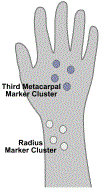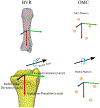Optical motion capture accuracy is task-dependent in assessing wrist motion
- PMID: 33752132
- PMCID: PMC8089049
- DOI: 10.1016/j.jbiomech.2021.110362
Optical motion capture accuracy is task-dependent in assessing wrist motion
Abstract
Optical motion capture (OMC) systems are commonly used to capture in-vivo three-dimensional joint kinematics. However, the skin-based markers may not reflect the underlying bone movement, a source of error known as soft tissue artifact (STA). This study examined STA during wrist motion by evaluating the agreement between OMC and biplanar videoradiography (BVR). Nine subjects completed 7 different wrist motion tasks: doorknob rotation to capture supination and pronation, radial-ulnar deviation, flexion-extension, circumduction, hammering, and pitcher pouring. BVR and OMC captured the motion simultaneously. Wrist kinematics were quantified using helical motion parameters of rotation and translation, and Bland-Altman analysis quantified the mean difference (bias) and 95% limit of agreement (LOA). The rotational bias of doorknob pronation, a median bias of -4.9°, was significantly larger than the flexion-extension (0.7°, p < 0.05) and radial-ulnar deviation (1.8°, p < 0.01) tasks. The rotational LOA range was significantly smaller in the flexion-extension task (5.9°) compared to pitcher (11.6°, p < 0.05) and doorknob pronation (17.9°, p < 0.05) tasks. The translation bias did not differ between tasks. The translation LOA range was significantly larger in circumduction (9.8°) compared to the radial-ulnar deviation (6.3°, p < 0.05) and pitcher (3.4°, p < 0.05) tasks. While OMC technology has a wide-range of successful applications, we demonstrated it has relatively poor agreement with BVR in tracking wrist motion, and that the agreement depends on the nature and direction of wrist motion.
Keywords: Accuracy; Kinematics; Optical motion capture; Soft tissue artifact; Wrist.
Copyright © 2021 Elsevier Ltd. All rights reserved.
Conflict of interest statement
Declaration of Competing Interest The authors declare that they have no known competing financial interests or personal relationships that could have appeared to influence the work reported in this paper.
Figures





Similar articles
-
Accuracy of biplane videoradiography for quantifying dynamic wrist kinematics.J Biomech. 2019 Jul 19;92:120-125. doi: 10.1016/j.jbiomech.2019.05.040. Epub 2019 May 29. J Biomech. 2019. PMID: 31174845 Free PMC article.
-
Carpal and forearm kinematics during a simulated hammering task.J Hand Surg Am. 2010 Jul;35(7):1097-104. doi: 10.1016/j.jhsa.2010.04.021. J Hand Surg Am. 2010. PMID: 20610055 Free PMC article.
-
Validation of the Leap Motion Controller using markered motion capture technology.J Biomech. 2016 Jun 14;49(9):1742-1750. doi: 10.1016/j.jbiomech.2016.04.006. Epub 2016 Apr 8. J Biomech. 2016. PMID: 27102160
-
Computer Modelling of Wrist Biomechanics: Translation into Specific Tasks and Injuries.Curr Rheumatol Rev. 2020;16(3):178-183. doi: 10.2174/1573397115666190119095311. Curr Rheumatol Rev. 2020. PMID: 30659546 Review.
-
Sex differences in wrist strength: a systematic review.PeerJ. 2023 Dec 14;11:e16557. doi: 10.7717/peerj.16557. eCollection 2023. PeerJ. 2023. PMID: 38107569 Free PMC article.
Cited by
-
Multi-Planar Cervical Motion Dataset: IMU Measurements and Goniometer.Sci Data. 2025 Jan 3;12(1):13. doi: 10.1038/s41597-024-04351-4. Sci Data. 2025. PMID: 39753563 Free PMC article.
-
Optical Motion Capture Systems for 3D Kinematic Analysis in Patients with Shoulder Disorders.Int J Environ Res Public Health. 2022 Sep 23;19(19):12033. doi: 10.3390/ijerph191912033. Int J Environ Res Public Health. 2022. PMID: 36231336 Free PMC article.
-
In Vivo Measurement of Wrist Movements during the Dart-Throwing Motion Using Inertial Measurement Units.Sensors (Basel). 2021 Aug 20;21(16):5623. doi: 10.3390/s21165623. Sensors (Basel). 2021. PMID: 34451068 Free PMC article.
References
Publication types
MeSH terms
Grants and funding
LinkOut - more resources
Full Text Sources
Other Literature Sources

